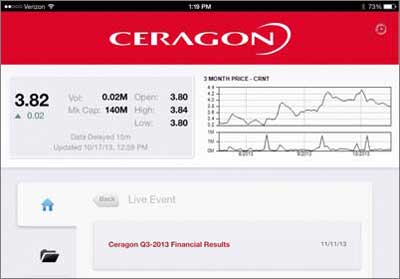New technologies are making information even more accessible and comprehensive
As with most functions within the IR profession, effective earnings calls rely on crystal-clear communications. Many firms have started to send out their investor announcements through emerging channels, including Twitter, as well as via new web-enabled technology, such as videoconferencing or online presentations, in a bid to make information as accessible and comprehensive as possible.
‘The fact is, if you want to attract investors, you have to meet them where they congregate. You have to speak a language they understand. You have to make them feel as though their voices will be heard,’ advises Sean McLaughlin, director of business development at social media company StockTwits.
For some, engaging with investors properly means using technology they are used to using elsewhere in their lives: why speak to your investors on a landline when they communicate with the rest of the world through their laptop? Where once a conference call was seen as the height of sophistication, these days social media, online content and streaming presentations appear to have taken over.
Twitter and StockTwits
At StockTwits, McLaughlin has overseen a number of his clients using new social channels to deliver their earnings calls to investors, including Ford Motor Company, Verizon and LinkedIn. At FedEx, the decision was made not only to share revenue and earnings numbers via the micro-blogging site, but also to field questions from the StockTwits community, which were then answered live during the firm’s conference call. The call is also broadcast online for investors to access as they wish, with an audio recording and any presentations being archived online for up to a year after the meeting itself.
For McLaughlin, the immediacy of Twitter is something any firm could benefit from. ‘If nothing else, these companies prove you don’t need to be a hot new consumer electronics company or a Wall Street darling to find utility in engaging your audience via social channels,’ he notes. ‘Each has investors, and they all want to be included in the conversation.’
Other firms that have enjoyed success with micro-blogging include real estate company Zillow. Its IR team was one of the first to take questions over Twitter through the #ZEarnings hashtag, as well as those posed via Facebook, as part of its webcast earnings call, hosted by the firm’s CEO Spencer Rascoff and CFO Chad Cohen.
Zillow’s open policy on social media means any investor can ask questions for the firm’s CEO and CFO to answer
In October Zillow partnered with the Motley Fool to offer investors the chance to talk directly with Rascoff immediately after the firm’s earning call, using the same hashtag and in the presence of the Motley Fool’s own analysts, Jason Moser and Matthew Argersinger. Though Zillow says it will entertain only ‘select’ questions during the call through social media in addition to those asked by those dialed into the conference call, investors are able to submit the inquiries well in advance, with those that gain the approval of their peers being given precedence.
The main advantage of earnings calls via this medium is that shareholders can benefit from a far more democratic forum for their inquiries. With such discussions taking part firmly in the public eye, says McLaughlin, IROs can engage with their stakeholders on a far more personal level.
‘Perhaps this is a newsflash to some finance professionals, but many casual investors have no idea what EBITDA, amortization or year-over-year organic growth mean,’ he explains. ‘They will respond to your story, though. They understand if you tell them that business is good or bad, and why. They want to know why you think next quarter or next year will be better. It’s best to drop the $20 MBA accounting words and just speak to them like real people.’
Broadcasting
For some companies, however, communications over social media can still represent an exercise in frivolity. In the vein of Yahoo! and Netflix, which both broadcast live earnings videos this year, many opt for a visual approach in the name of clarity, such as Finnish real estate firm Technopolis. In 2012 it hosted an innovative virtual conference for retail investors across nine of its offices, despite being separated by many hundreds of miles. Since then, the technology has also been used for the firm’s earnings calls. 
Technopolis’ well-equipped virtual conference center allows investors to chat in real time to the firm’s management across hundreds of miles
A facility equipped with a number of high-definition webcams and the ability to directly broadcast into eight other conference rooms meant Technopolis could speak with investors and analysts as if they were in the same room. Though the firm is based in Helsinki, up to 100 users can meet management, hear presentations and ask questions via one of its video conferencing suites, based in offices in 11 cities spread across countries as far flung as Russia, Estonia and Lithuania.
Pasi Hiedanpää, IR and communications manager at Technopolis, says the system saves time and money, allowing his team to reach investors they would otherwise never meet – including shareholders as far afield as Lappeenranta in Finland, a location so remote that any visit would involve unfeasibly distant travel. ‘For overseas investors, too, it’s very useful,’ adds Hiedanpää. ‘We are hoping to use the technology to speak with investors in London and Amsterdam soon so that we can save money and avoid long travel times by not commuting.’
Feedback has been ‘great’ so far, Hiedanpää notes. ‘After the first virtual conference last year, we’re hoping to host another this year, but as we’ve been busy with investment and an upcoming share issue, we haven’t decided yet,’ he adds. ‘We’re very happy with the system: it’s working really well. We’ve also been active on Twitter and are looking carefully at blog writing and other web conversations. We like having the ability to send comments to investors should they have any misunderstandings.’
Apps and beyond
Though online technologies offer a number of new solutions for earnings calls, most of the time they still require both your investors and board members to be seated behind a computer monitor. For those on the move, a more bite-sized approach could mean a better rate of uptake for your announcement. ‘Usually at earnings calls you’re faced with a number of questions: where are people? How are they going to engage with us?’ says Jeff Corbin, founder of theIRapp. ‘So far, interested parties are calling, either on a mobile or landline, or they can listen to the call live through a desktop computer. These are the only options that exist right now.’
Companies powered by theIRapp include US wireless service provider Ceragon
Corbin poses a solution in the form of a native smartphone application. ‘Firms that have it can open up a range of information to investors,’ he explains. ‘In an earnings call situation, investors can open the company’s app, simply click on ‘live call’ and have it streamed straight to their phone, presuming they have an internet connection.’ Following the call, users can access an archived MP3 of the presentation that can be listened to later, even without online access.
Ahead of the game
Companies that have already adopted such a solution include Colgate-Palmolive and Edwards Lifesciences. The latter, explains Corbin, has a website produced by Shareholder.com that can be resized for iPhone browsing. As a native app, theIRapp offers content that is tailored to be viewed on a smartphone. ‘Companies are figuring out what their IR mobile solutions are, and whether they need a native app or a responsive design website,’ says Corbin. ‘It depends upon the user experience a company would like to offer’.
Many IR departments may not quite have the budget to develop such solutions in-house. ‘One of the challenges is that if a company develops solutions itself, it can end up being a very expensive process,’ notes Corbin. ‘We can save costs with our existing platform.’
He also understands that there are regulatory factors to be careful of. With a more immediate and open form of communication, company messages need to remain watertight, in terms of meeting best practice guidelines for governance and disclosure. ‘From a disclosure standpoint, it’s just a matter of putting the news out when you need to put it out,’ Corbin explains. ‘People understand Reg FD and the rest, so as long as IR professionals know what is required of them and apply it to new technologies, they should be fine.’
Sticking to the rules
McLaughlin offers a similar warning. ‘I would tell all companies that use StockTwits – and, by extension, Twitter – to disclose financial information not to attempt to reinvent the wheel on social media,’ he cautions. ‘It’s OK – even encouraged – to try some new ideas when you’re comfortable, but you should start with distributing the important information you’re already distributing via press releases, conference calls and investor days.’
At the same time, investors will already be used to consuming large quantities of data at once. A working paper overseen by Gwen Yu and Francois Brochet at Harvard Business School earlier this year, entitled ‘Capital market consequences of non-plain English in conference calls of foreign firms’, advises that investors will expect to be engaged at a level they are used to in the rest of the online world. As Yu writes in her report: ‘It’s important to be able to cater to investors’ appetite for information’, whatever that may be.
‘Investors are no longer happy being fed with only the information managers decide to give them. There are high expectations for more qualitative information,’ Yu goes on to say of social media. ‘There is a tremendous amount of pressure, but if you are a good communicator, you can look at it as a big opportunity.’
McLaughlin concludes, however, that a common sense approach to social media will ultimately prevail. ‘This information won’t necessarily get you into any hot water,’ he says. ‘Just break it into bite-sized pieces, link back to longer-form content and attach disclaimers where necessary.’










